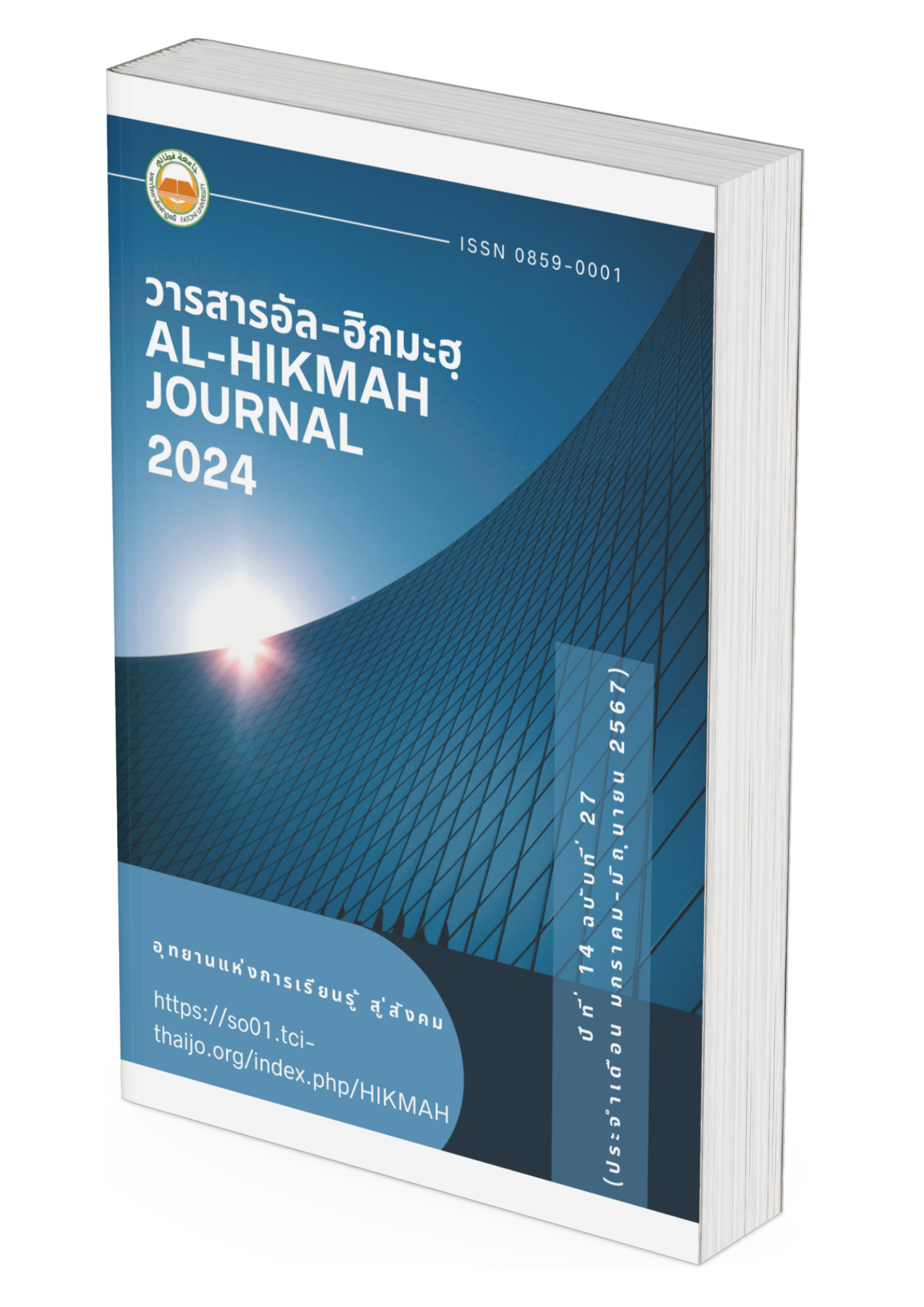The Development of Al-Quran Recitation Skill through CIRC Technique Using Electronic Book for Intermediate Islamic Studies Stage Students, Year 2
Keywords:
Al-Quran Recitation Skill, CIRC Technique, Electronic BookAbstract
ABSTRACT
The purposes of the research were 1) to develop and determine the efficiency of the lesson plans of Al-Quran recitation skill through CIRC technique using electronic book, 2) to compare the reading skill between pre-test and post-test achievements for intermediate Islamic studies stage students, year 2, 3) to study the achievements of intermediate Islamic studies stage students using CIRC technique between pre-test and post-test, and 4) to study the students’ satisfaction towards instruction by using CIRC technique. The samples of this research were 23 intermediate Islamic studies stage students, year 2 of Prichayan Wittaya School in the second semester, academic year 2022. The research instruments were 1) the six lesson plans on Al-Quran recitation skill through CIRC technique using electronic book, 2) a 30-question of learning achievement test, 3) reading skill assessment form, and 4) the satisfaction questionnaire of students towards Al-Quran recitation skill through CIRC technique using electronic book. The statistics used in this research were mean, percentage, standard deviation, and t-Test.
The results of this research were as follows;
- The efficiency of the lesson plans of Al-Quran recitation skill through CIRC technique using electronic book was equal to 82.02/93.11 which was higher than the predetermined criterion 80/80.
- The reading skill achievements of intermediate Islamic studies stage students, year 2 between pre-test and post-test were different, which the
post-test scores were higher than the pre-test scores. - The students’ achievements between pre-test and post-test were different which the post-test scores were higher than the pre-test scores at statistical significance level of 0.05.
- The students’ satisfactionof Al-Quran recitation skill through CIRC technique using lesson plans was at a high level.
References
กระทรวงศึกษาธิการ. (2553). หลักสูตรอิสลามศึกษา ตามหลักสูตรแกนกลางการศึกษาขั้นพื้นฐาน พุทธศักราช 2551. กรุงเทพฯ : โรงพิมพ์ชุมนุมสหกรณ์การเกษตรแห่งประเทศไทย.
กษมาภรณ์ ใจว่อง เรื่องการใช้เทคนิค CIRC (Cooperative Integrated Reading and composition) เพื่อพัฒนาทักษะการอ่านภาษาอังกฤษเพื่อความเข้าใจสำหรับนักเรียนชั้นประถมศึกษาปีที่ 4. การค้นคว้าอิสระ หลักสูตรปริญญาการศึกษามหาบัณฑิต สาขาวิชาภาษาอังกฤษ พฤษภาคม 2564 มหาวิทยาลัยนเรศวร.
กัณณ์ภัสสร์ ทำประดิษฐ์. การพัฒนาความสามารถในการอ่านและการเขียนสะกดคำ โดยใช้การจัดการเรียนรู้ แบบร่วมมือเทคนิค CIRC สำหรับนักเรียนชั้นประถมศึกษาปีที่ 4 THE DEVELOPMENT IN READING AND SPELLING ABILITIES OF THE 4 TH GRADE STUDENTS THROUGH CIRC TECHNIQUE-BASED LEARNING ACTIVITIES มหาวิทยาลัยภาคตะวันออกเฉียงเหนือ Received May 10, 2021; Revised July 12, 2021; Accepted August 25, 2021 วารสาร มจร อุบลปริทรรศน์ ปีที่ 6 ฉบับที่ 2 (พฤษภาคม-สิงหาคม 2564)
จิราวรรณ มีมาก. (2559). การพัฒนาความสามารถด้านการเขียนสะกดคำของนักเรียนชั้น มัธยมศึกษาปีที่ 1 โดยใช้กิจกรรมการเรียนรู้แบบร่วมมือเทคนิค CIRC ประกอบแบบฝึกทักษะ. มหาวิทยาลัยราชภัฏมหาสารคาม.
รอฮีมะห์ เด็ง. (2561). การพัฒนาทักษะการอ่านภาษาอาหรับโดยใช้เทคนิคการเรียนการสอนแบบร่วมมือผสมผสานการอ่านและการเขียนสำหรับนักเรียนชั้นประถมศึกษาปีที่ 5. วิทยานิพนธ์ครุศาสตรมหาบัณฑิต สาขาวิชาการสอนอิสลามศึกษา บัณฑิตวิทยาลัย มหาวิทยาลัยราชภัฏยะลา.
สมาคมนักเรียนเก่าอาหรับ ประเทศไทย. (2542). พระมหาคัมภีร์อัลกุรอานพร้อมความหมายภาษาไทย. อัลมะดีนะฮฺ อัลมุเนาวะเราฮฺ : ศูนย์กษัตริย์ฟาฮัด เพื่อการพิมพ์อัลกุรอาน.
Muhammad bin Ismail Albukhari. (2008). Sohih Bukhari. Darulibnikasir : Birut Lubnan.
Muslim bin Ibnuhajad. (2010). Sahih Muslim. Darulkutub Ilmiyah : Birut Lubnan
Downloads
Published
How to Cite
Issue
Section
License
Copyright (c) 2024 Al-HIKMAH Journal

This work is licensed under a Creative Commons Attribution-NonCommercial-NoDerivatives 4.0 International License.



